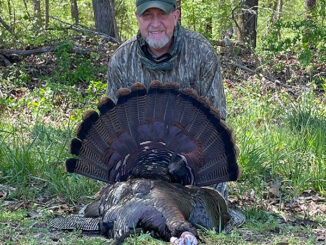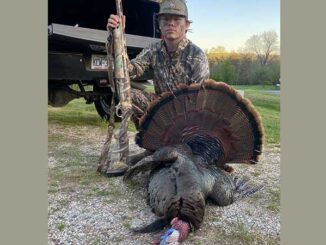
Crankbaits, soft plastics, jigs, flutter spoons and blade baits are top summer producers
When the largemouth bass spawn is complete and the shallow bite fades at Falls of the Neuse Lake, guide Joel Munday goes out on a ledge.
The post-spawn movement of bass to offshore ledges is a migration pattern that’s almost consistent as clockwork and one that Munday has noted since he began guiding full-time at the 12,410-acre impoundment north of Raleigh and Durham.
After bass finish spawning, they abandon the shallows in pursuit of forage, which moves to deep water as the summer months approach. This movement takes place along old creek channels that serve as underwater highways.
Munday said the bass migration is driven more by their predatory nature than by water temperature, though the latter is a contributing factor.
“It’s more of a forage thing, with the fish seeking their main food supply and their familiar deep-water haunts,” said Munday. “The fish are mainly after the threadfin shad.”
The migration, he said, usually begins in late May, although weather variables can hasten or slow down the movement.
“By the first week of June, the migration is definitely underway,” said Munday, a Raleigh resident who runs Outdoor Expeditions Guide Service.
As bass migrate along the old creek channels or “highways,” one of their favorite gathering places is a ledge.
What’s a ledge?
Munday defines a ledge as a subtle or significant drop along a creek or main-lake channel, hence, the designation “drop-fishing” by some anglers for fishing ledges. Munday also considers a drop along an underwater roadbed as a form of ledge. The composition of a ledge can be rock, clay, or mud.
Though the drops that constituting ledges vary in depth, knowing when to target shallow or deep drops is one of the keys to successful ledge fishing.
Falls of the Neuse is actually two lakes in one, with NC 50 serving as an imaginary dividing line. The difference between the two halves of the lake makes finding ledges with shallow or deep drops easier.
Shallow drops can be found at the upper end of the lake west of NC 50. That part of the lake is characterized by wide shores and depths rarely exceeding 12 feet except for the original Neuse River channel. From the beginning of the migration through June, Munday fishes ledges in this area with 5- to 8-food drops.
Deep drops are abundant in the “lower lake” downstream and east of NC 50, where the lake narrows and steep banks and water depths plunging to 30 feet are the norm. On this end of the lake, Munday will target ledges with drops ranging from 10 to 18 feet as the summer progresses and the heat intensifies.
While the lake’s topography aids fishermen in their search, the use of electronics in conjunction with a contour map is necessary for locating specific ledges and the idiosyncrasies that make some more productive than others.
“For ledge fishing, your best friends are your depth finder and your map,” said Munday. “Visually scanning the landscape reveals few telltale signs about where ledges might be. A newcomer should examine a map before coming to the lake to locate creek-channel and main-lake contours and bends.”
Munday said a GPS unit is a great time-saver for returning to a ledge or marking cover on a ledge.
Just as some piers and tree laps always hold fish and some rarely do, the same holds true with ledges. Some ledges may attract a few fish, while others draw large concentrations of bass. Not many structural features or types of cover can lure fish in those numbers.
For that reason, offshore anglers covet ledges; they can really “mop up” if they find the right ledge.
Munday said the better ledges have features that make them magnets for large numbers of fish, such as cover in the form of stumps, rocks, brush or an irregularity such as a rock lip, creek or channel-bend location or a bump.
Of course, the presence of forage is always important.
“It takes something extra to make some ledges better than others,” said Munday. “Cover is always a bonus if it’s there. Look for these extras with your electronics and mark them with your GPS.”
For ledge fishing, Munday comes equipped with deep-diving crankbaits, Texas- and Carolina-rigged plastics, heavy jigs, flutter spoons and blade baits.
Here’s how he uses these fishing tools, beginning with crankbaits.
Munday’s cranking choices include the Rapala DT Series and Luhr Jensen’s Hot Lips Express baits in shad patterns with some chartreuse and blue backs.
“The dingier the water, the more chartreuse I want in the bait, though Falls usually doesn’t become too muddy” he said. “The upper end may have more color to it.”
For Munday, boat positioning is the key to fishing ledges with crankbaits. He may set up beyond the ledge and make long casts that give his baits time to achieve the desired depth before reaching the target. Ideally, the bait should bump along the ledge tracking its curvature, before diving off the lip.
Munday’s other approach involves positioning his boat so upon retrieve, the bait dives into the channel before bumping its way up the front of the ledge. Finally, he may fish the ledge parallel to make the bait bounce along its sides. He also factors in the effect of current if the lake is being pulled. Fish often face into the current or linger behind a current break caused by cover or ledge formations.
“Falls isn’t pulled as hard as other lakes, but the current generated does have a major impact upon the fishing,” said Munday. “The crankbait bite improves with pulled water.”
Munday avoids cranking deep ledges after heavy rains, because bass return to the shallows when the water gets dingy. He’ll follow them to the bank, flipping tree laps, flooded grass and other shoreline cover.
For cranking, Munday uses a medium-action 7-foot-9 graphite Carrot Stick rod paired with a Shimano Curado reel with a 5-to-1 retrieve ration, arguing that “faster” reels make a crankbait rise rather than dive to the desired depth. He spools his reels with 12-pound Segaur Inizx fluorocarbon, which helps a bait dive to its maximum depth.
He uses the technique made popular by Lexington crankbait expert David Wright, with one significant modification.
“While Wright uses a graphite rod with little give in combination with fishing line with lots of stretch, I use a graphite rod with little give in combination with fluorocarbon line that has virtually no stretch” said Munday. “It works for me.”
If sluggish fish won’t strike a moving crankbait, or if the intense summer heat pushes bass deeper and beyond the diving capabilities of some crankbaits, Munday switches to a Texas- or Carolina-rigged Zoom trick worm or Ol’ Monster worm. He drags the rig slowly until it falls over the ledge. This allows him to feel subtle differences and cover along the ledge that might not appear on a depth finder. Munday also jerks the rig along the ledge to provoke strikes from reluctant bass that react to the sudden movement.
Munday fishes soft plastics on a medium-heavy 7-foot-6 Carrot stick and a Curado reel spooled with 15- to 20-pound fluorocarbon. On his Carolina rig, he employs a 24- to 36-inch leader of 10- to 14-pound line and a wide-gap, Gamakatsu hook.
He’ll also fish a 3/4-ounce football jig with a Zoom Super Chunk or plastic critter for a trailer. He selects jigs and plastic trailers in black/blue for stained water and green pumpkin and peanut butter/jelly colors for clear water.
Munday retrieves the jig with a lift-and-drop motion or scurries it along the bottom kicking up dirt in the manner of a crawfish. Most strikes come with the jig on the fall or dropping off the end of the ledge.
Another bait in Munday’s bag of ledge tricks is a flutter spoon, a huge s-shaped spoon weighing more than an ounce, such as the Lake Fork Flutter Spoon, BPS Nitro Spoon, and Strike King Sexy Spoon. Munday favors spoons in silver or green finishes.
These spoons flutter to the bottom with a lift-and-drop jigging retrieve or twitching motion and can be dropped in front of the fish. With a slow retrieve, the spoon slithers from side to side. Too fast a retrieve will make the spoon spin wildly.
A fisherman’s heart will go a-flutter when he gets a bite with one of these spoons. The flutter spoon is known for catching big bass rather than numbers of bass.
Munday also likes a blade bait, such as a 1/2-ounce Damiki Vault, a heavy metal lure that can be jigged liked a spoon or retrieved to dig up the bottom like a crankbait. It can be cast a long distance in the stiffest of winds, which gives it an advantage over many other lures and rigs.
For big spoons and blade baits, Munday uses a medium-heavy rod-and-reel outfit and 65- to 80-pound test braided line.
Munday said the ideal day for ledge fishing is one with a slight breeze, some water current, slightly stained water, and with fish hugging the deeper ledges. Given these conditions, anglers can expect to catch numerous bass in the 3- to 3 1/2-pound range plus a kicker fish or two.
Conversely, a day with strong winds, no water current and muddy water caused by heavy rains puts a damper on ledge fishing.
When beating the banks starts to yield few returns by late spring, don’t jump off a cliff in frustration. Instead, go out on a ledge for bass. The effort will pay off in fishing dividends.
DESTINATION INFORMATION
WHERE TO GO — Falls of Neuse is a 12,410-acre impoundment on the Neuse River that runs from north of Durham through Durham, Granville and Wake counties to the dam north of Raleigh. I-85, NC 50 and NC 98 provide good access to different parts of the lake. Popular access areas include: Ledge Rock off US 15 just north of the I-85 crossing; the Upper Barton Creek access on NC 1005 (Six Forks Road) a mile south of NC 98, and the NC 50 Recreation Area at the NC 50 bridge across the lake.
WHEN TO GO/TECHNIQUES — The best ledge fishing for largemouth bass begins in late May and runs through the summer. Big stringers of bass can be taken from offshore ledges in five to 18 feet of water using deep-diving crankbaits, Carolina- and Texas-rigged plastics, football jigs, flutter spoons, and blade baits. Baitcasting tackle and 12-to 15-pound test line is recommended.
GUIDES/FISHING INFO — Joel Munday, Outdoor Expeditions Guide Service, 919-669-2959; Outhouse Tackle, Raleigh, 919-847-1222. See also Guides and Charters in Classifieds.
ACCOMMODATIONS — Sleep Inn Wake Forest, 866-538-0154; Hampton Inn Raleigh-Wake Forest, 866-925-7881; Super 8, Raleigh, 866-538-9334; and Comfort Suites North Raleigh, 866-538-6270. Camping is available at the Falls Lake State Recreation Area, 919-733-4181.
MAPS — Kingfisher Maps, 800-326-0257, www.kfmaps.com; Fishing Hot Spots, 800 ALL-MAPS, www.fishinghotspots.com; U.S. Army Corps of Engineers, Falls Lake Visitor Assistance Center, 919-846-9332.








